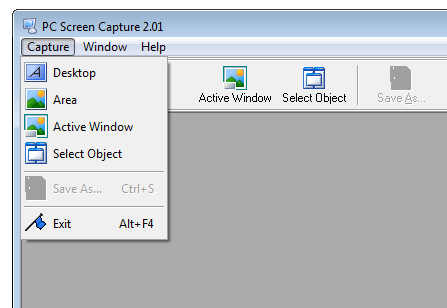Please watch version 2 of this video here: the 'install failed' and 'No packages were eligible for install'. Sep 23, 2021 After restarting several times, OS X is still on screen telling me that 'no packages were eligible for install'. Oct 24, 2019 OS X El Capitan remains available for Mac computers that can't upgrade to macOS Catalina, Mojave, High Sierra, or Sierra, or that need to upgrade to El Capitan first.
Jun 22, 2018 We are hoping that you were able to fix the macOS Install issue using some of these tips. If you have tried everything without any success, your best bet is to reach out to Apple Support folks so that they can help out.
When the warning “macOS could not be installed on your computer” or “The path /System/Installation/Packages/OSInstall.mpkg appears to be missing or damaged” is thrown during a macOS High Sierra install on a hackintosh it’s usually caused by one of two things.
I first noticed this problem when installing the High Sierra 10.13 Supplement Update (17A405) and only happens when installing macOS over an Intel iGPU or a Nvidia GPU.
The cause of the error is usually one of two things: GPU or SMBIOS. Here’s how to fix both:
1. Graphical Cause
If you got this error when installing macOS with an Intel iGPU or Nvidia GPU then it’s likely you have EmuVariableUefi-64.efi in your EFI partition. This driver can cause an issue during the install of High Sierra which can produce the above error and removing it will remove the error.
- Mount your EFI partition using Clover Configurator
- Navigate to EFI/Clover/Drivers64UEFI/
- Delete EmuVariableUefi-64.efi
- Restart and try to complete the installer again
If this solves the error. Add EmuVariableUefi-64.efi back into your EFI folder if you plan to use a dedicated graphics card by opening your config.plist in Clover Configurator and selecting Install Drivers on the left column menu.
2. SMBIOS Cause
If the errormacOS could not be installed on your computer persists after removing EmuVariableUefi-64.efi, then a bad SMBIOS setting could be what’s behind it. If the SMBIOS spoof is too old (i.e. 2011 or earlier) the installer will detect that the “Mac” as too old to run High Sierra. Verify the spoofed SMBIOS being used is based on a Mac that came out in 2012+ or later. The SMBIOS spoof can be changed in Clover Configurator.
If the installer can’t match the firmware and BIOS version with known values the error will also be thrown. Generate a new SMBIOS using Clover Configurator to fix the firmware issue, then restart your hackintosh and try the installer again.
3. System Time Cause
If the time in BIOS does not match the apple time of your installer this error can be thrown if it’s outside the macOS Installer’s allowed tolerance. For example if you are using a motherboard/laptop that’s been in storage awhile the system time may not match the installer’s time.
See:For anyone who can’t install macOS because “the Installer is Damaged”
4. NVRAM Cause
If you are updating from an earlier version of macOS and getting this error you can try clearing out the NVRAM.
- Open Terminal & type:
sudo nvram -c
5. Dirty Drive Cause
The drive you are installing macOS could be the source of the problem and this was the cause with an install I recently did. I tried installing High Sierra 10.13.2 on an old drive running Sierra 10.12.6. Despite it being a separate partition no matter what I did I was still getting the error. I then decided that it must have been the drive itself because and it was.
I backed up all my files on a separate drive to transfer back later and used Disk Utility to erase the drive I wanted to install High Sierra. That did the trick and I was able to complete the install without getting the error.
Exciting a new version of macOS is exciting. But it can quickly become frustrating if, instead of being presented with a brand new Mac, ready to use, you see an error message like “macOS could not be installed on your computer.” Fortunately, there are lots of things you can do to fix the problem, so let’s get started.
Macos No Packages Were Eligible For Install Windows 10
Before you try to install a new version of macOS
It’s essential that before you perform any major upgrade, say from Mojave to Catalina, that you backup your Mac. One of the steps described below involves a complete reinstall of the operating system, which could result in you losing data. It’s best if you can do the backup using Time Machine, as you can then use Recovery Mode to restore your Mac from the backup. But if you don’t want to use Time Machine, create a bootable clone of your startup disk using a tool like SuperDuper or Carbon Copy Cloner.
Why does “macOS could not be installed on your computer” appear?
There are a number of reasons you might see this error message. Here are some of the most common.
- Your Mac doesn’t support the version of macOS you’re trying to install
- There was a problem downloading the installer
- You don’t have enough space to install a new version of macOS
- There’s a problem with the disk on your Mac
- A piece of software like a launch agent or launch daemon is interfering with the upgrade
Before you try to fix the error
Check if your Mac is compatible with the version of macOS you’re trying to install. The best way to do that is to launch the App Store app, search for the macOS version you’re trying to install and scroll down the Compatibility section. You should see a message that says “works on this Mac”. Alternatively, go to Apple’s website support pages and search for the minimum system requirements. You might need to reboot in Safe mode, see below, to check because if you do a normal restart, your Mac may immediately launch the installer again.
How to fix “macOS could not be installed on your computer”
1.Restart your Mac in Safe mode
Safe mode disables startup items, launch agents, and everything else except the bare minimum macOS needs to function. Restart your Mac from the Apple menu or by holding down the power button, and press Shift until you see the Apple logo.
2. Try running the installer again while in Safe mode
If the problem was that launch agents or daemons were interfering with the upgrade, Safe mode will fix that. If it works, you should restart your Mac normally after the installation and remove any launch agents and daemons you don’t need.
The simplest way to remove launch agents is to use CleanMyMac X.
Here’s how:
- Download, install, and launch CleanMyMac X.
- Choose Optimization from the sidebar on the left.
- Select View all items.
- Check the box next to Launch Agents
- Press Run.
3. Free up space
You’ll need up to 20GB of free space on your main drive to download and install an update to macOS. If you don’t have that much free space, it’s time to clear out the junk and free up space. I’ve found that the quickest and easiest way to do that is to use a popular app CleanMyMac X by MacPaw. It can free up tens of gigabytes of space with a couple of clicks.
Install CleanMyMac X, then launch it — download free edition here.
- Choose Smart Scan from the sidebar.
- Press Scan.
- When it’s finished, press Run to delete files immediately, or Review Details to see what it has found.
4. Reset the NVRAM
The NVRAM on your Mac stores data even after your Mac shuts down or restarts, unlike regular RAM which is flushed every time you restart. NVRAM persists, thanks to a small amount of power supplied by your Mac’s internal battery. Resetting NVRAM rarely has any effect, but it can do in some situations, and as it won’t do any harm, it’s worth trying. It’s quite tricky to do, so you might need some help.
Restart your Mac while holding the Command + Option (Alt) + P + R keys and wait until you hear a startup chime. It may take a little longer than normal to restart, and may restart twice, but once it’s done, the NVRAM will have reset.
5. Try the combo updater
Macos No Packages Were Eligible For Install
If you can restart in Safe mode and quit the installer, try downloading the combo updater from Apple’s website. The combo updater contains all the files necessary to install macOS on all Macs, whereas the version downloaded from the App Store only has the files for your specific Mac. It may be that the combo updater works, where the Mac App Store version doesn’t.
Macos No Packages Were Eligible For Install For Home
6. Install in Recovery Mode
This is the last resort, if nothing else works.
Macos Mojave No Packages Were Eligible For Install
- Restart your Mac while holding Command + R until you see the Apple logo.
- When you see the macOS Utilities window, you have two choices. You can either restore your Mac from a Time Machine backup, if you have one, which will take you back to where you were before you started. Or you can Reinstall macOS.
- Choose the option you want.
- If you chose Reinstall macOS, wait for your Mac to restart, then go to System Preferences>Software Update and update your Mac to the latest available version.
There are a number of things you can do to fix your Mac when you see the message: “macOS could not be installed on your computer.” If the problem is that you don’t have enough space, you can use CleanMyMac X to get rid of files you don’t need. Otherwise, go through the above steps one at a time until you’re able to install a new version or update to macOS.
Macos Install Application
These might also interest you:
If you ever get this error while attempting to install OS X, you will likely need to set the date using terminal.The simplest way to set it (if you have no OS installed on the machine) is to boot the install media, open the terminal and check the date (type date).

No Packages Eligible For Install Macbook Pro
The following information was found on someones site (sorry I forget which), but I have included it here to make it easier to correct this issue.Use the following command in terminal to set the machine to a time and date of your choosing:
date {month}{day}{hour}{minute}{year}
For example, to set it to 8pm on the 2nd October 2018
date 100220002018
The command below will output the current date in a format suitable for use on another machine:
date '+%m%d%H%M%Y.%S'
Further, the following (mouthful of a command) will let you specify a date and time in a more readable format and set it in one go:

